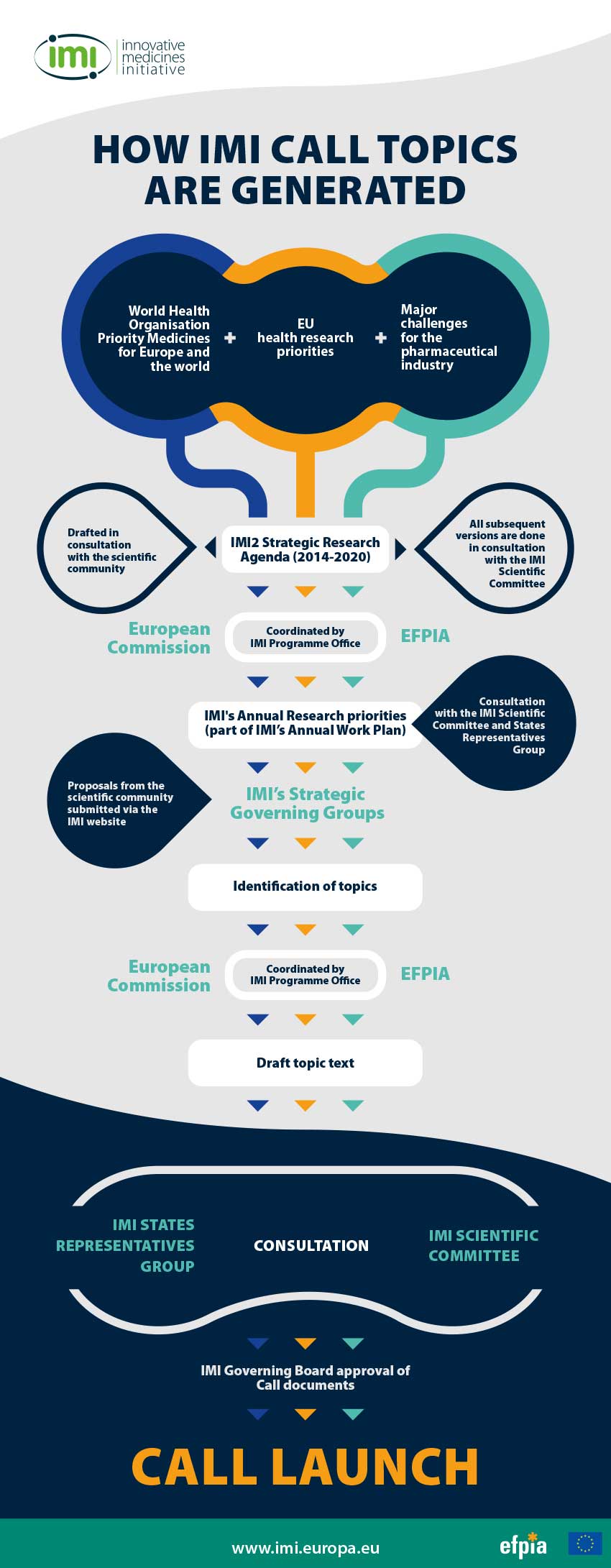The IMI Call process
IMI Calls for proposals are open and competitive, and winning proposals are selected following evaluations by independent experts and approval by the IMI Governing Board. Most Calls for proposals involve a two-stage process as outlined below. Details of the rules and processes for each Call are always set out in the Call documents, and you should read these carefully as on occasion, they may differ from the standard process described below.
Before the Call launch - Topic development
 A consortium of EFPIA companies and, in some cases, IMI Associated Partners, agree on the need to work together and with other stakeholders on a specific issue. These issues must be aligned with IMI’s objectives and the IMI Strategic Research Agenda. Ideas for topics can come from EFPIA companies or Associated Partners, or from suggestions submitted by external organisations.
A consortium of EFPIA companies and, in some cases, IMI Associated Partners, agree on the need to work together and with other stakeholders on a specific issue. These issues must be aligned with IMI’s objectives and the IMI Strategic Research Agenda. Ideas for topics can come from EFPIA companies or Associated Partners, or from suggestions submitted by external organisations.
The topic text is drafted by the EFPIA/Associated Partner consortium and, following extensive discussion with the European Commission and consultation with various groups (including the IMI Scientific Committee and the States Representatives Group), the Call text is sent to the IMI Governing Board for approval.
When the topic texts are at an advanced stage, we often publish the drafts on the Future Topics page of our website to give potential applicants additional time to prepare applications. All information on the Future Topics page is indicative and you should bear in mind that topics can change a lot or even be dropped during the topic development stage.
Stage 1: Call launch, submission and evaluation of short proposals
Once the Governing Board has given its green light, the Call for proposals is published on the IMI website and the Funding & Tenders Portal. All interested parties from academia, small and medium-sized enterprises (SMEs), mid-sized companies, patient organisations, regulatory agencies, health technology assessment bodies, etc. are invited to form consortia and submit a short proposal, via the Funding & Tenders Portal, in response to the Call. At this stage, applicants generally should not include EFPIA companies or IMI Associated Partners in their consortium. Typically, the submission deadline is around three months after the Call launch.
Following the submission deadline, the proposals are first screened for eligibility (i.e. to check the proposal was submitted on time and is complete, and that basic requirements on things like the number of participants have been met). All eligible proposals are then evaluated by independent experts, who score them based on three top-level criteria: excellence; impact; and quality and efficiency of the implementation. The evaluation process is monitored by independent observers who ensure that IMI applies the rules correctly and treats all applicants fairly. The independent observers’ reports are published on the Call documents pages of the IMI website.
Finally, the experts rank the applications by score, and the IMI Governing Board approves the results of the evaluation. The applicant consortium that submitted the top-ranked application is then invited to proceed to Stage 2.
Under exceptional circumstances, the IMI Governing Board may deviate from the ranking established by the independent experts by applying objective criteria.
Stage 2: Submission and evaluation of full proposals
In Stage 2, the top-ranked applicant consortium and the EFPIA/Associated Partner consortium behind the topic join together to form a full consortium and submit a full proposal. Consortia usually have around three months to prepare the full proposal. Once submitted, the full proposal is also evaluated by independent experts and the evaluations are again monitored by independent observers. At this stage, as there is only one (full) applicant consortium per topic, there is no ranking. However, if a full proposal’s scores are below the thresholds set out in the rules, it will not be recommended for funding. Once the results of the Stage 2 evaluation have been approved by the Governing Board, the consortium can start preparations to launch the project.
Project preparation
Before an IMI project can start, the consortium, in collaboration with the IMI Programme Office, needs to finalise two important documents: the Grant Agreement and Consortium Agreement (known as the Project Agreement in IMI1 projects).
The Grant Agreement governs the relationship between the project and IMI. In addition to a detailed description of the project, the Grant Agreement covers things like the project’s duration and budget, details of eligible costs, the role of third parties, rules for reporting on project deliverables and submitting cost claims, intellectual property, dissemination and communication, and the roles and responsibilities of the different partners. There is a standard template for the Grant Agreement.
The Consortium Agreement governs the relationship between the project partners. Signed by all partners, it deals with issues such as project governance, liability, and intellectual property. There is no fixed template for the Consortium Agreement, as it should be adapted to the needs of each project. A sample template prepared by EFPIA shows what a consortium agreement might look like. However, consortia may use alternative templates if they wish.
Project launch
Once the Grant Agreement and Consortium Agreement have been signed, the project can officially start!
Other Call processes
Although most IMI Calls for proposals follow this two-stage approach, IMI also launches other types Calls for proposals (for example through a single-stage procedure). The details of the process for each Call are always described in detail in the Call documents, and potential applicants are advised to read these carefully and contact IMI in case of any questions.

